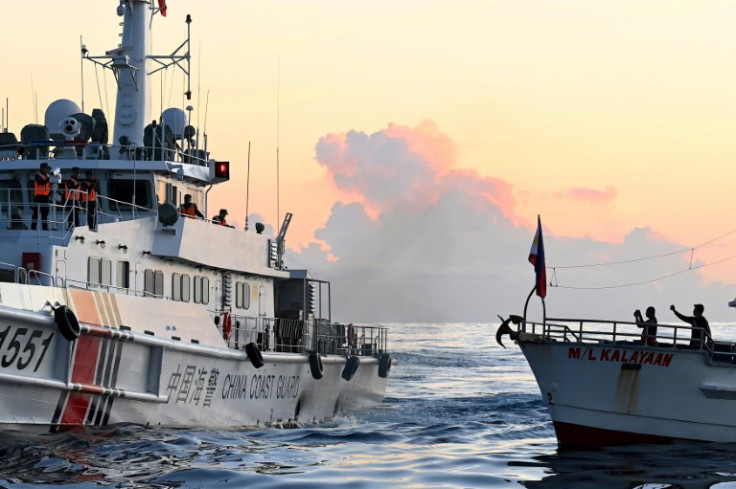
KEY POINTS
- The ridge is outside the 10-dash line that China has established to assert its territorial claims
- Marcos Jr. raised "great concern" over the spotting of two Chinese "research" vessels within Philippine Rise baselines
- The UNCLOS commission recognized Philippine Rise as being within Philippine jurisdiction in 2012
- China's Xi urged Chinese armed forces to prepare for possible maritime conflicts
China and the Philippines have long been at odds over territorial waters in the South China Sea, but a new storm is brewing between the Asian countries as Chinese vessels were recently spotted "loitering" in the vicinity of the Philippine Rise, an extinct volcano ridge located approximately 250 kilometers east of the Philippine municipality of Dinapigue.
Fast facts about the 'undisputed' ridge
For starters, the Philippine Rise, formerly called Benham Rise, is not within the infamous U-shaped 10-dash line that Beijing claims is part of China's territorial waters. It is located in the Philippines' eastern border – very much far from the disputed West Philippine Sea.
Which country has jurisdiction over the area?
Philippine Rise is not a disputed territory, unlike the contentious Scarborough Shoal (Bajo de Masinloc or Panatag Shoal in the Philippines and Huangyan Island in China), and the vast Spratly Islands, which is under an ongoing dispute between China, the Philippines, Taiwan, Malaysia, Vietnam and Brunei.
The Philippine Rise is widely considered an extended part of the country's continental shelf and is not being disputed by any other nation. However, two Chinese "research" vessels were spotted "loitering" in the area on March 3, triggering a check by a Philippine Coast Guard (PCG) offshore patrol vessel. The research ships left the area later in the day. Still, their presence left a mark on Manila, which has, since the entry of a new administration, expressed increasing frustration over the Chinese Coast Guard's harassment of Philippine ships in Scarborough Shoal and the Second Thomas Shoal (Ayungin Shoal in the Philippines and Ren'ai Jiao in China).
The said island features are both within the Philippine exclusive economic zone (EEZ) – an area of the sea that a sovereign state has exclusive rights to in terms of marine activities, energy production and exploration as prescribed by the 1982 United Nations Convention on the Law of the Sea (UNCLOS). A country's EEZ extends 200 nautical miles (230 miles) beyond a country's territorial sea.
Marcos raises alarm over Chinese 'intrusion'
Philippine President Ferdinand "Bongbong" Marcos Jr. called the incident "a clear intrusion into our Philippine maritime territory," saying it was "of great concern." The Philippine Navy has since reassured the public that it was monitoring the area.
The reported sightings of Chinese research vessels in the Benham Rise is “of great concern,” President Ferdinand Marcos Jr. said.@pcogovph @bongbongmarcos @pr1ncegolez pic.twitter.com/fFPOIe8qiM
— Politiko Watch (@PolitikoWatch) March 7, 2024
Inside the thousand-meter deep, possibly resource-rich ridge
Analysts and maritime experts have said the Philippine Rise may be rich in natural gas and other resources, including heavy metals. According to the Philippine National Museum, the ridge is about 3,000 to 3,500 meters deep – an approximately 24 million-hectare undersea region that is home to rare corals and hundreds of marine species. "Its diverse ecosystem attracts and serves as spawning ground and nursery of migratory fishes like the highly-valuable Pacific Bluefin tuna," the museum noted.
In 2018, then-President Rodrigo Duterte declared the undersea feature as a Marine Resource Reserve. Under his proclamation, some 50,000 hectares of the area has been designated as a "Strict Protection Zone" that is only limited to scientific studies by Filipino researchers. Also, over 300,000 hectares of the Philippine Rise was designated as a Special Fisheries Management Area.
Why Philippine Rise is within Philippine jurisdiction
Three years after the Philippines asked the UNCLOS Commission on the Limits of the Continental Shelf to recognize Benham rise as part of Philippine territory, the Commission adopted its sub-commission's findings that agreed with the Philippines' claim of then-Benham Rise being within Manila's territorial jurisdiction.
Beijing extends iron hand way beyond South China Sea
In the case of Philippine Rise, China's decades-long territorial dispute with the Philippines over the South China Sea is out of the question.

"What we have here is a different way in which China disregards international law," Gregory B. Poling, director of the Center for Strategic and International Studies' (CSIS) Southeast Asia Program and Asia Maritime Transparency Initiative, told International Business Times.
Poling noted that China may conduct research within Philippine EEZ with Manila's permission. The Philippines "must give that permission unless China's vessels are believed to be conducting environmentally harmful activities or illegally gathering information for resource extraction," he added. Beijing doesn't seem to have sought permission before its research ships entered Philippine Rise. "That is illegal," Poling pointed out.
A pattern of Chinese territorial harassment
Even with Scarborough Shoal and Second Thomas Shoal being within Philippine EEZ, Beijing has not bothered to seek permission, repeatedly claiming that the said island features are part of China.
Poling said Beijing's display in the Philippine Rise is "similar" to how it has been acting within Philippine archipelagic baselines. "Chinese military and survey vessels have repeatedly lingered in Philippine archipelagic waters in clear violation of UNCLOS, which says they must transit through in an expeditious manner," he said.
At forefront of 'World War II-style' war?
During an address at the ASEAN-Australia summit late last month, Marcos Jr. flashed back to the time in World War II when Filipinos and Americans fought side-by-side to withstand the Japanese invasion that resulted in the deaths of more than a million Filipinos.
"As in 1942, the Philippines now finds itself on the frontline against actions that undermine regional peace, erode regional stability, and threaten regional success. Then as now, we remain firm in defending our sovereignty, our sovereign rights, our jurisdiction," he said.
Marcos Jr., unlike his predecessor ex-President Rodrigo Duterte, has been more vocal against China's aggression in the West Philippine Sea. He has also been forging ties with other nations to help expand international support for his country's territorial sovereignty, most recently with Czech Republic.
Rising higher from the ashes of colonization
Earlier this week, Marcos Jr. vowed that the government will continue defending its maritime territory following comments from Chinese President Xi Jinping that the Chinese armed forces should be prepared "for maritime military conflicts."
"We will have to continue to do what we can to defend our maritime territory in the case of perhaps a more active attempt by the Chinese to annex some of our territory," he said.







